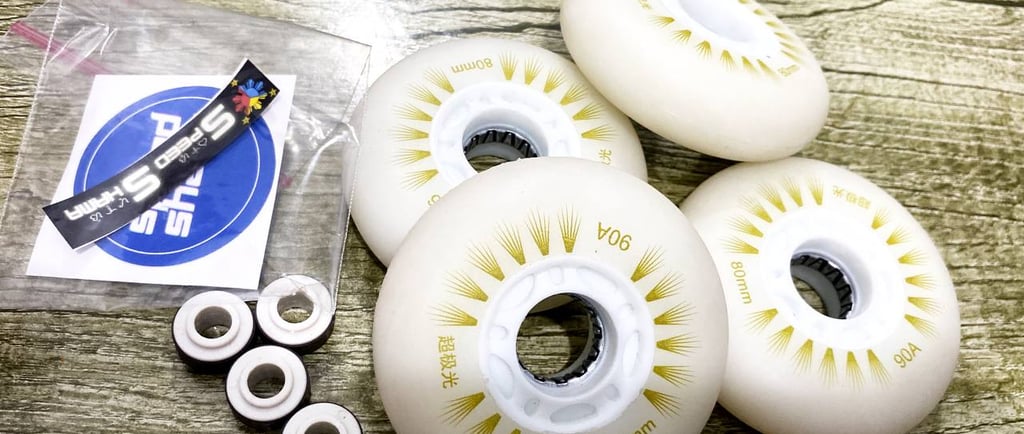Wheel Spacers: Use-Cases, Examples, and Benefits!
When to use spacers?
EDUCATIONAL
SpeedShama
5/26/20244 min read


What Are Inline Skating Wheel Spacers?
Inline skating wheel spacers are essential yet often overlooked components found within the wheels of inline skates. These small cylindrical devices are strategically placed between the bearings inside the wheel hub. Their primary purpose is to ensure that the bearings are properly aligned and securely held in place, which is crucial for the optimal performance and safety of the skates.
The physical characteristics of wheel spacers can vary, but they are typically designed to fit snugly within the wheel hub, providing a stable and balanced environment for the bearings. Most spacers are cylindrical in shape with a central hole that aligns perfectly with the axle of the wheel. This alignment ensures that the bearings remain parallel and evenly spaced, preventing any lateral movement that could compromise the stability of the skate.
Wheel spacers are commonly made from materials such as aluminum and plastic. Aluminum spacers are favored for their durability and strength, which can withstand the rigors of intense skating activities. They are lightweight yet robust, making them an excellent choice for skaters seeking high performance. On the other hand, plastic spacers are often used in more recreational or entry-level skates. While they may not offer the same level of durability as aluminum spacers, they are cost-effective and sufficiently reliable for less demanding skating conditions.
The contribution of wheel spacers to the overall performance and safety of inline skates cannot be overstated. By maintaining the correct spacing and alignment of the bearings, spacers play a critical role in reducing friction and ensuring smooth wheel rotation. This not only enhances the skater's speed and maneuverability but also helps to prevent premature wear and tear on the bearings. Moreover, properly installed spacers can minimize the risk of bearing failure, which could lead to accidents or injuries. Therefore, understanding and maintaining these small yet vital components is essential for any inline skater aiming to achieve a safe and enjoyable skating experience.
Use-Cases and Scenarios for Inline Skating Wheel Spacers
Inline skating wheel spacers serve a crucial role in various skating disciplines, offering distinct advantages tailored to specific needs. Understanding these scenarios can help skaters make informed decisions about incorporating wheel spacers into their gear.
Competitive Racing
In competitive racing, every fraction of a second counts. Inline skating wheel spacers are invaluable in this context as they minimize bearing movement, leading to enhanced speed and consistency. For instance, professional racers often opt for high-precision spacers that ensure the bearings remain perfectly aligned within the wheels, reducing friction and promoting smoother, faster rotations. The primary benefit here is the potential for improved lap times and a more consistent performance. However, the downside is that high-quality spacers can be costly, and the need for precise installation may require advanced technical skills.
Recreational Skating
For casual skaters, the focus shifts to stability and smoothness. Inline skating wheel spacers contribute significantly to a more enjoyable skating experience by ensuring even pressure distribution across the bearings. This results in a smoother ride, reducing vibrations and making it easier to maintain balance. For example, families enjoying a day at the park or individuals skating for fitness can benefit from the enhanced stability provided by spacers. The advantages include increased comfort and reduced wear on the wheels and bearings. On the flip side, while the initial cost is relatively low, some skaters may find the installation process slightly daunting without prior experience.
Aggressive Skating
Aggressive skaters, who engage in tricks and stunts, require gear that can withstand substantial impact. Inline skating wheel spacers offer the necessary durability and reliability in such demanding conditions. By keeping the bearings securely in place, spacers help prevent damage from hard landings and abrupt maneuvers. For example, skaters performing grinds and jumps benefit from the added structural integrity that spacers provide. The main advantage here is the increased lifespan of the bearings and wheels. However, aggressive skaters should be aware that spacers need regular inspection and maintenance to ensure they continue to perform effectively under high-stress conditions.
In summary, whether it's the pursuit of speed in competitive racing, the quest for a smooth ride in recreational skating, or the demand for durability in aggressive skating, inline skating wheel spacers offer targeted benefits that enhance the overall skating experience. Understanding these use-cases allows skaters to select the appropriate spacers for their specific needs, optimizing performance and enjoyment.
Selecting and Installing Inline Skating Wheel Spacers
Choosing the right inline skating wheel spacers is fundamental to achieving optimal performance and ensuring the longevity of your skating setup. The selection process begins with understanding your specific skating needs and the type of wheels you are using. Inline skating wheel spacers come in various sizes, typically ranging from 6mm to 8mm, and are made from materials such as aluminum or plastic. For speed skaters, lightweight aluminum spacers are often preferable due to their durability and reduced weight, whereas recreational skaters might find plastic spacers adequate for their needs.
To select the appropriate wheel spacers, first, identify the axle size of your inline skates. Measure the internal diameter of your wheels to ensure compatibility with the spacer size. It's essential to match the spacer size precisely to avoid any wobbling or misalignment. Additionally, consider the type of skating you will be doing; aggressive skaters may require more robust spacers to withstand the impact of tricks and jumps.
Once you have selected the correct spacers, the installation process can begin. You will need basic tools such as a skate tool or an Allen wrench, and optionally, a bearing press for easier installation. Follow these steps for a seamless installation:
1. Remove the wheels from your skates by unscrewing the axle bolts.
2. Extract the bearings from the wheels using a bearing puller or manually if necessary.
3. Insert the spacers into the wheel hub, ensuring they are centered and flush with the wheel.
4. Reinsert the bearings into the wheels, pressing them firmly to secure the spacers in place.
5. Reattach the wheels to your skates, tightening the axle bolts securely but not excessively to avoid damaging the bearings.
To maintain your wheel spacers, periodically check for any signs of wear or damage. Clean the spacers and bearings regularly to prevent debris accumulation, which can affect performance. Avoid common mistakes such as over-tightening the axle bolts or using incompatible spacers, as these can lead to poor alignment and reduced efficiency.
By carefully selecting and properly installing your inline skating wheel spacers, you ensure a smoother ride, enhanced performance, and prolonged durability of your skating equipment.
Contacts
information@skateshop.cc
Socials
Subscribe to our newsletter
Links
Shop Links
